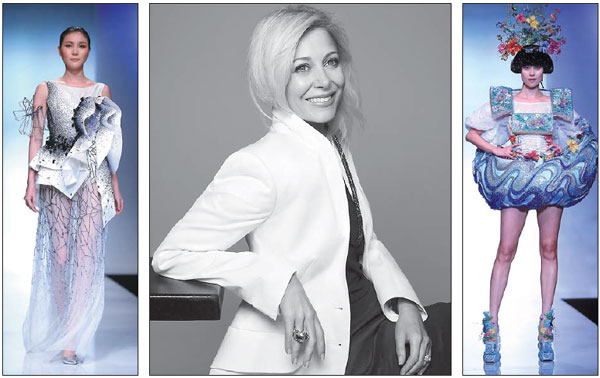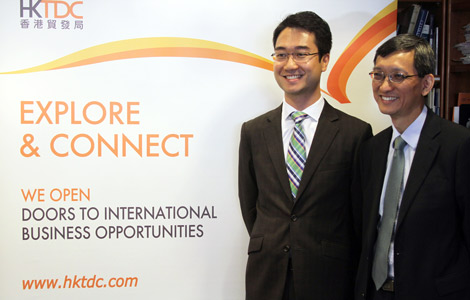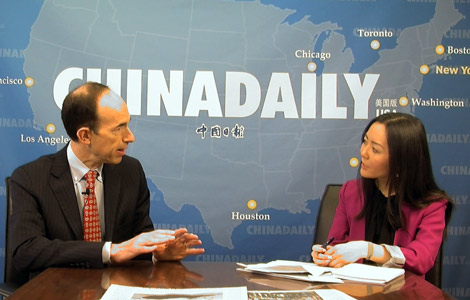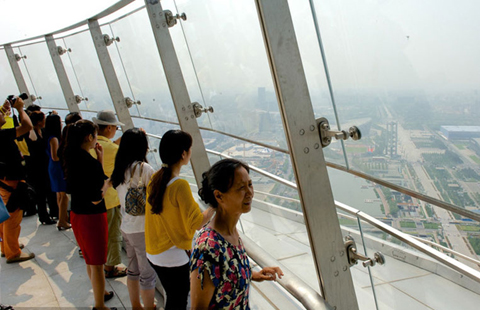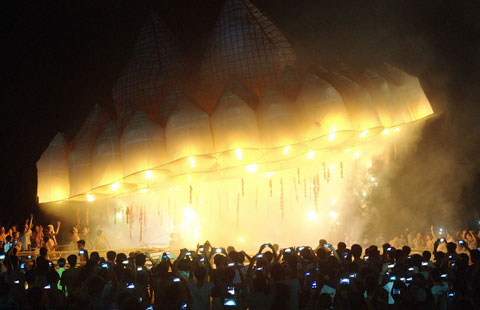Swarovski has crystal-clear vision for Chinese market
Updated: 2014-10-06 14:17
By Cecily Liu(China Daily)
|
||||||||
Austrian fashion house already has 245 stores in 71 cities across the country
Austrian crystal brand Swarovski's success in China is symbolic of a trend of female liberation in the country, observes Nadja Swarovski, fifth-generation heir to the business.
She recalls her first visit to China in 1992, when the city was full of bicycles and men and women in gray suits, an image in sharp contrast with how the city is today.
|
Nadja Swarovski (center) says Swarovski's special efforts to design jewelry pieces targeting Chinese consumers have helped with sales. Photos provided to China Daily |
"The last time I visited, there were no bikes and no gray suits. I see it as a human revolution, and in particular a female revolution. The Chinese lady is allowed to wear a pink shirt and wear jewelry, and I think this is where Swarovski steps in," Swarovski says.
The confidence and luxury lifestyle Swarovski helped to bring to the modern Chinese women is just like the change it impacted on Western women centuries ago when her great-great-grandfather Daniel Swarovski founded the business in Austria in 1895.
At the time, diamonds were popular with aristocrats, but Daniel Swarovski famously said that every woman who cannot afford a diamond should have a crystal. It is a part of a revolution in mindset in which middle class women can enjoy fashion, and this trend is happening in China today.
"Swarovski's mission is to empower the customer, to make women feel good about themselves and express themselves. We know from studies that jewelry is the strongest means of expression. So if we can help women do this, we will be on the right track," she says.
Swarovski's first store in Hong Kong opened in 1972, and its first in the Chinese mainland in 1989.
Now, Swarovski is expanding in China at a rate of 25-30 stores a year. It already has stores in most tier-one and tier-two cities, and plans further growth. It has 245 stores in China covering 71 cities. For the past two years, revenue from the China market has accounted for 10 percent of the company's total revenue.
"The Chinese market appreciates Swarovski crystal because we're a European brand, with European craftsmanship," Swarovski says.
She adds that the company's special efforts to design jewelry pieces targeting Chinese consumers have also helped with sales. The 12 animals of the Chinese zodiac are a commonly used theme, and Swarovski has noticed an increase in sales of particular animals during the year devoted to them in the Chinese calendar.
Many Swarovski pieces targeting Chinese consumers are designed by young Chinese designers, including Masha Ma, Wang Peiyi and Ye Mingze.
Ye, for example, has designed the famous collection Flower and Seed of Love for Atelier Swarovski, which is a high-end product range for the brand. The design is built around the pattern of a six-petal symmetrical flower consisting of many smaller triangular patterns, which amazes viewers with its attention to detail.
Swarovski says her team met many of these Chinese designers through friends and partners in China, and she is amazed by their creativity and skills. Many of them have at some stage received education in the West, which made them appreciate Chinese traditions more upon returning, she says.
One example is Swarovski's participation in the 2013 Beijing Design Week, where Chinese and international designers were invited to create innovative designs with Swarovski crystal, using the theme of exploring memory in the digital age.
At the exhibition, Chinese designer Liu Feng created an installation known as Milky Way, which uses a mountain of crystals to represent refracted memory in the digital age. "It shows the function of the crystal as a lens if you light it from different angles," Swarovski says.
Beijing-based furniture designer Song Tao embedded crystals in wood and bamboo in a piece known as The Story of Time, which aims to reflect the memory of birth, growth and death.
In April this year, Swarovski also presented a new installation to coincide with Art Basel in Hong Kong.
Entitled Prologue, it is a giant 4-meter outdoor sculpture, holding more than 8,000 Swarovski crystals, by London-based design duo Patrik Fredrikson and Ian Stallard. The installation plays with natural light by transforming and transmuting its environment throughout the day.
Last year Swarovski took the fashion show Runway Rocks to Shanghai in collaboration with Lane Crawford. Runway Rocks was a fashion show Swarovski originally staged in London a decade ago.
"At Runway Rocks, we got Asian designers to show their ultimate catwalk piece, to celebrate the industry and to get people to think outside of the box," says Swarovski.
She was born in Germany in 1970. She joined Swarovski in 1995, starting her career in Hong Kong, where she stayed until 1997. She says she chose Hong Kong for its fast flow and can-do attitude.
"In 1992 I visited the Chinese mainland with my father on a business trip. I don't know when and how but I decided I will live there. Three years later I figured out how to live there," she says.
Not only did she enjoy living in Hong Kong, but the city's distance from Swarovski's home market also gave her an opportunity to see the business from a holistic perspective, or a "bird's eye view" in her own words.
"There's so much energy and so much to be done. Modernization was on the way, and everyone had so much to do," she recalls.
At Swarovski, she is known for bringing a fashion focus to the brand, which started merely as a supplier of crystal, with its best-selling consumer products being cute crystal animal figurines. She brought about this change by introducing a series of collaborations with well-known fashion designers, famously with Alexander McQueen, but also Philip Treacy, Hussein Chalayan and Giles Deacon.
"I just put the crystals in his hands and let his imagination go wild," she recalls of the collaboration with McQueen.
"In the late 1990s, people thought crystals are just clear and bling, but actually we have so many shapes and colors of crystals, and that really came through with the work of McQueen," she says.
cecily.liu@chinadaily.com.cn
(China Daily USA 10/06/2014 page15)

 Visitors trade cash for luck at World Heritage site
Visitors trade cash for luck at World Heritage site Sharapova beats Kvitova to win China Open
Sharapova beats Kvitova to win China Open
 China-Mexico ties deepen
China-Mexico ties deepen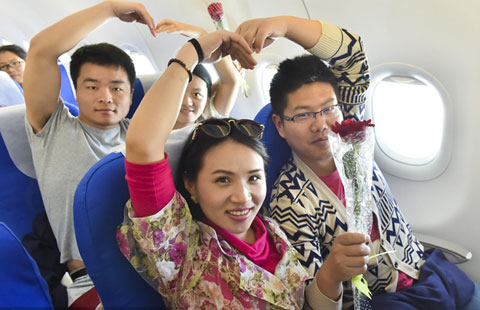
 58 couples say 'I do' among the clouds
58 couples say 'I do' among the clouds
 Chinese convoy fleet executes escort missions in Gulf of Aden
Chinese convoy fleet executes escort missions in Gulf of Aden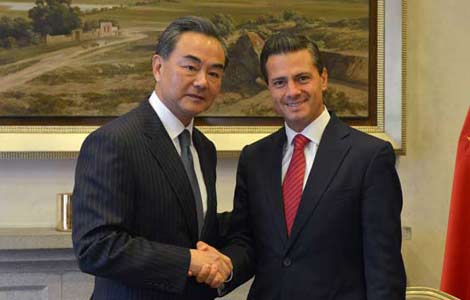
 Chinese FM Wang Yi meets with Mexican president
Chinese FM Wang Yi meets with Mexican president
 China leads medal table as Asian Games close
China leads medal table as Asian Games close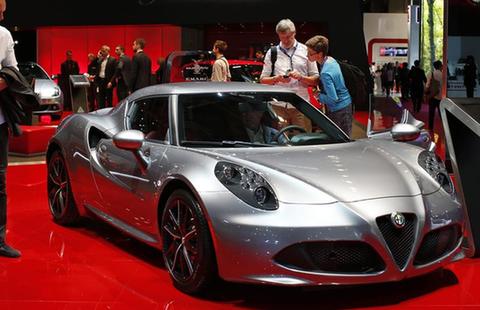
 Highlights at Paris auto show
Highlights at Paris auto show
Most Viewed
Editor's Picks

|

|

|

|

|

|
Today's Top News
HK officials resume work as protests thin
Brazil's Rousseff to face Neves in rival in runoff
Some protesters in HK decide to withdraw
China startups 'get smart' about healthcare devices
US, India stir S. China Sea debate
Brazilians more aware of breast cancer symptoms, survey finds
Ebola patient in Dallas struggling to survive, says CDC head
Ebola could reach France and UK
US Weekly

|

|
